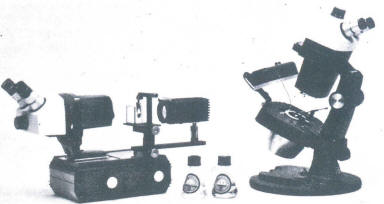Gemolite is of American origin and was developed especially for diamond grading by the gemological Institute of America (GIA) (Fig 152).
It is equally well suited to the examination of colored gemstones and can quickly be transformed into an ideal colored stone microscope.
| The firm Eickhorst has especially developed a compact and
functional microscope stand which can be used for the
traditional testing of gemstones in an immersion liquid. For
this the gemolite optical part is simply transposed on the
stand. A polarization unit can be inserted between the paths of
the rays within seconds and thus enables a dazzle-free
observation of the inclusions, their double and single
refraction as well as anomalous double refraction. With this the
Gemolite can be used by a gemologist as a universal microscope
(Fig 153). |
 |
The Gemolite consists of two parts, the optics and the light source. The optical part contains a Bausch & Lomb stereo-zoom microscope with binocular tube and enables a plastic and three-dimensional image of the object to be presented. The magnification is continuously variable from 10 x to 45 x and permits a further doubling by the use of an additional lens.

Fig, 153 GEMOLITE rigged for colored gemstone examination
The upper part of the instrument may be tilted to adjust a suitable viewing height. The oculars are provided with eye shields which can screen off distracting sidelight effects and can be adjusted to the individual distance between the eyes. The wide interval between the pupils of the wide-field oculars and the broad field of vision under 10x to 20 x magnification allow for comfortable observation even by wearers of spectacles. The oculars allow for a field of vision of extreme sharpness from the centre to the edge. In order to equalize a possible difference in sharpness of vision between the two eyes, it is possible to focus both oculars independent from one another.
The lower part of the instrument houses the light source which was developed by GIA. By insertion or removal of a black disc it allows the stone to be examined by transmitted light (light field illumination) as well 90S by lateral light (dark field illumination). Dark field illumination is particularly suited for diamond examination. The built-in parabolic mirror directs a cone of light through an opaque glass filter from below up into the stone. All possible surface reflections and luster are eliminated and only the internal features illuminated. A built-in diaphragm varies the size of the opening for the transmission of the light and in this way the light intensity can be regulated.
An important additional tool is the stone holder for
loose and mounted stones of normal sizes. It is fixed to the object
table and can be removed without difficulty to enable firmer grasp of
the stones. The clamp can be rotated and moved upwards and downwards.
The brilliant is firmly held in the mechanical
tongs and yet can be easily viewed from all sides.
In conjunction with the color-Grader already described, the Gemolite can also be used for color-grading. For this purpose the color-Grader is equipped with an additional light source.
Other commercially available diamond microscopes
differ in their optics, light source and magnifying possibilities. The
supply of microscope models today is quite big. The author therefore
does not want to describe individual models .
Apart from that, the acquisition of such an instrument is dependent on
capital availability, necessary scope and other factors already
mentioned.
| Models of Microscopes | Diascope Diamond Stereo Zoom microscope |